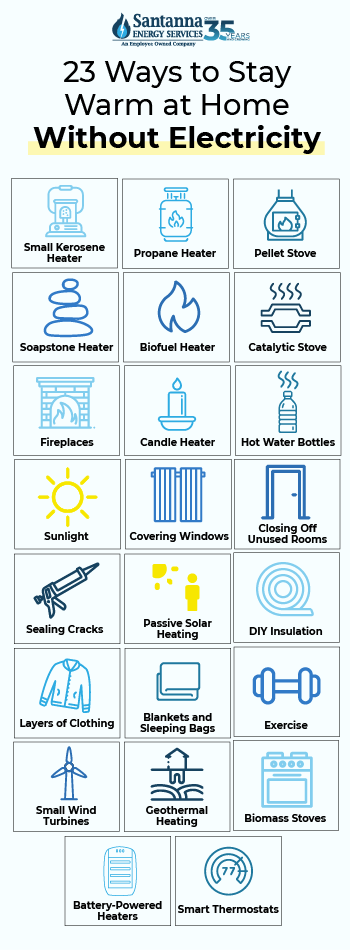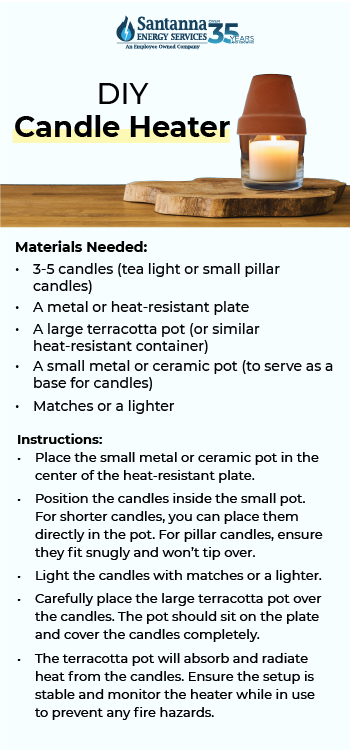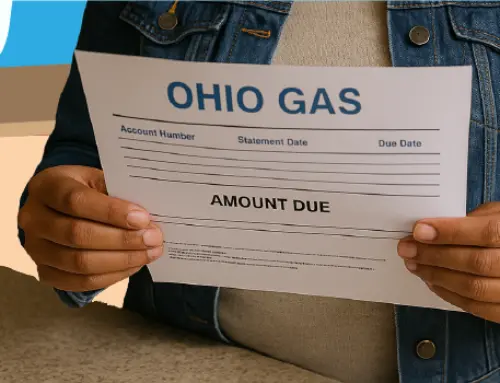23 Ways How to Heat Your Home Without Electricity
by Tyler Castle
10.3 min read

As the world becomes increasingly aware of the need for energy efficiency, finding ways to heat your home without relying on electricity is more important than ever. Whether you’re looking to reduce your energy usage or cut down on your carbon emissions from fossil fuels, we’re sharing practical tips on how you can heat your home without electricity.
Key Points of This Article:
- Kerosene heaters can warm your home during outages because they generate heat and light through combustion.
- Propane heaters work well without electricity since propane can be stored as a liquid and used when other fuels are unavailable.
- Adding insulation to drafty spots such as attics and basements helps keep warm air inside your home.
- Battery‑powered heaters offer a simple backup heating option when the power goes out.
While we’ll share different heating methods that involve heating units, we’ll also cover DIY solutions to keep yourself comfortable with minimal to no cost.

Alternative heating sources
Heating your home without electricity is no easy task. If your electricity goes out in your home, here are a couple of alternative heating sources you can use to keep your home warm and toasty:
Small kerosene heaters
Kerosene heaters are a great way to keep your home warm without electricity. Small kerosene heaters produce heat and light through a combustion process. Unlike electric heaters, kerosene heaters operate independently from your home’s power supply. This means that small kerosene heaters won’t add any extra energy consumption to your energy bill while your electricity is out.
While Kerosene heaters are manufactured with numerous safety features, human error can occur if users use gasoline instead of kerosene as a fuel source and don’t supply proper ventilation. Be sure to follow the guide that comes with your heater to ensure proper safety.
Propane heaters
Propane heaters offer a versatile and efficient solution for heating your home without electricity. Utilizing propane as a fuel source, these heaters generate warmth through a combustion process that doesn’t rely on electrical power. Unlike natural gas, propane can be stored as a liquid and burned in emergency situations.
As another pro, propane has a higher energy content per unit volume than natural gas. This means you can burn less fuel for longer. Many propane heaters are designed with safety features such as automatic shut-off mechanisms and oxygen depletion sensors.
Pellet stoves
Pellet stoves are highly efficient and eco-friendly when considering carbon emissions. Pellet stoves often burn compressed wood pellets that provide a steady source of heat. Unlike traditional wood stoves, pellet stoves are equipped with a hopper that automatically feeds pellets into the combustion chamber, ensuring a consistent burn and minimal manual intervention. This makes pellet stoves one of the best ways to heat your home without electricity.
Soapstone heaters
Soapstone heaters are an excellent choice for heating your home without electricity because of their natural heat-retaining properties. Crafted from dense, heat-absorbing soapstone, these heaters absorb and store heat from a fire, then slowly release it over time, providing consistent and efficient warmth. Soapstone is a natural rock that was formed millions of years ago under intense heat and pressure. Because of its stable composition, soapstone can take on scorching temperatures while still providing strong heat.
Biofuel heaters
Like biomass, bioethanol fuel, or “biofuel” is produced using plants like sugarcane, straw and other crops. Biofuel or ethanol-based heaters burn cleanly, they do not contribute particulates or harmful emissions into your indoor environment. The organic materials that can be used to create this fuel can be grown yearly, which is why biofuel heaters and heat can be considered renewable.
Catalytic heaters
Catalytic heaters rely on a small amount of natural gas and catalytic reactions to create heat. This flameless combustion process makes catalytic heaters exceptionally safe. Infrared gas catalytic heaters convert as much as 98% of the energy they use into heat; this makes them highly efficient. Additionally, their portable design allows you to easily move them to different areas of your home.
Fireplaces
Fireplaces have long been a trusted and traditional method for heating homes without electricity. Unlike electric heaters, fireplaces rely solely on wood combustion to produce heat, making them independent of any power grid. Fireplaces also offer the added benefit of continued operation during power outages. As a bonus, fireplaces can add a touch of beauty to your home by adding an extra aesthetic appeal.
Keep in mind that fireplaces require ventilation. Without proper ventilation leading smoke into your outdoor space, you could be subjected to significant health risks.
DIY ways of heating your home without electricity
If you’re in a jam, DIY-ing your own heating solution could be a better option for you. Here are a couple of clever ways you can heat your home without electricity through a DIY solution:
Candle heaters
Candle heaters, though simple, can be a surprisingly effective way to provide warmth in your home without electricity. These heaters typically involve placing a few candles beneath a terracotta pot or similar heat-resistant material. This material then, absorbs and radiates the heat from the candles outward.
While this method doesn’t generate a lot of heat to warm an entire room, this is a good solution for individual heating in a pitch. Here’s how you can make a DIY candle heater of your own:

If you’re not in a jam for heat, be sure to keep these materials on hand for an emergency later. For your protection, ensure you manage these substances cautiously and use oven gloves to prevent scorching your hands.
Water bottles for personal heating
Using water bottles for personal heating is a simple yet effective way to stay warm without electricity. By filling a hot water bottle with heated water, you can create a portable source of warmth that provides comfort in chilly conditions. The heat from the water bottle can be placed directly on your body or tucked into blankets, beds, or clothing to maintain warmth.
This heating method not only conserves energy but it’s great for individual heating. Be sure to wrap your warm water bottle in a towel before it makes contact with your skin to avoid burning.
Letting sunlight in during the day
Heating your home without electricity can be as simple as opening your shades and curtains. Sunlight is a powerful source of thermal energy, and by opening your curtains, blinds, or shutters, you can harness this energy to warm your living spaces. South-facing windows are particularly effective at capturing sunlight, as they receive the most direct sunlight throughout the day.
Covering windows
In winter, about 30% of a home’s heating energy is lost through windows. Covering windows or adding shades can lock the heat within your room in. This not only helps to maintain a cozy indoor temperature but also reduces the strain on your heating system, leading to lower energy bills.
Closing off unused rooms
By shutting doors to rooms that aren’t frequently used, you limit the area that needs to be heated, allowing the warmth to concentrate in the spaces you occupy the most. In the same way, closing off air vents in unused rooms can circulate air to rooms that need it more. This method is particularly useful during power outages or when you’re trying to minimize energy consumption, as it allows you to make the most of any available heat sources.
Sealing cracks to prevent heat loss
Consider using window film or weatherstripping to seal gaps around the window frames. Layering different types of window coverings, such as combining blinds with curtains, can further enhance heat retention. Air gaps in your windows and doors can lead to significant heat loss during the winter.
The cheapest ways to heat your home
Should you be in search of cost-effective methods to warm your house without using electricity, continue reading for the comprehensive list!
Passive solar heating
Passive solar heating is a method of harnessing the sun’s natural energy to heat a home. This can be as simple as opening curtains during the day and using thermal drapes at night. With this method, you won’t be using any external or additional heating sources which promotes energy-efficiency.
If you’re interested in solar passive heating home design, placing your windows to the south or choosing a location with minor or no sunlight obstructions can increase passive solar heating in your home.
DIY insulation
Adding extra insulation to drafty areas in your home – like attics and basements – is one of the best ways to keep heat within your home. If you’re looking for a budget-friendly solution, materials like weather stripping, heavy curtains, or plastic window covers can do the trick.
Wearing layers of clothing
Wearing layers of clothing is a simple yet powerful way to keep warm and reduce the need for heating your home without electricity. By layering up, you create pockets of air between each layer of clothing, which act as insulation, trapping body heat and keeping you warmer for longer. Start with a base layer made of moisture-wicking material to keep sweat away from your skin, followed by insulating layers such as wool or fleece to retain warmth.
Using blankets and sleeping bags
Blankets provide immediate insulation by trapping your body heat and creating a warm microclimate around you. Layering multiple blankets or using heavier, insulated ones can enhance this effect, keeping you cozy even in a cold room. Sleeping bags, particularly those designed for cold weather camping, offer even greater warmth due to their snug design and thermal insulation properties.
Staying warm through exercise
Physical activity boosts your circulation and increases your core temperature. This extra body heat can help you stay warm if you’re without electricity. Engaging in activities like jumping jacks, running in place, or even simple stretches can generate warmth and improve overall comfort in a chilly environment.
Underutilized heating solutions
Small wind turbines
While not ideal for every household because of their costly installation, mini wind turbines can be a clever way to generate heat for your home. According to Energy.gov, small wind turbines can lower your electricity bill by 50%-90%. Small wind turbines can also provide interruptible power supply through extended power outages.
Geothermal heating
Geothermal energy generates heat from naturally decaying radioactive materials such as uranium and potassium. This energy can be used to heat and power homes. The constant temperature of the Earth, just a few feet below the surface, provides a stable and reliable source of heat throughout the year.
Biomass stoves
These stoves burn organic materials such as wood pellets, corn, or agricultural residues to produce heat, harnessing the energy stored in these renewable resources. Unlike electric heaters, biomass stoves operate independently of your home’s power supply, making them ideal for areas with unreliable electricity or during power outages.
Plus, the purchase of certain biomass stoves can qualify you for an ENERGY-STAR tax credit!
Battery-powered heaters
Battery-powered heater can provide an easy solution to heating your home when electricity isn’t available. These heaters are designed to operate using rechargeable batteries, making them a convenient option for situations such as power outages or remote locations where access to electricity is limited. Ensure you have a few pre-charged batteries on hand for emergency situations.
Smart thermostats
Smart thermostats can be paired with non-electric heat sources to help you manage and optimize heating efficiency. In the same way, you can program your smart thermostat to adjust temperatures to energy-efficient temps to help conserve energy.
Effective off-grid or emergency heating requires careful planning and flexibility to ensure comfort and safety. At Santanna Energy Services, we understand the importance of reliable energy solutions. We’re here to support you no matter your energy needs with quick customer service and innovative home energy solutions for any of your energy goals.
There’s peace of mind in knowing you’ll pay the same monthly supply cost amount for your electricity or natural gas supply without any uncertainty — no matter what. Santanna’s Unlimited Energy option protects your bills from fluctuating supply charges no matter the changes in seasons. For over 35 years, Santanna has served customers in Illinois, Indiana, Pennsylvania, Michigan, and Ohio. Our mission is to provide innovative and cost-effective energy solutions that will help our customers achieve their energy goals.
Tyler is an experienced energy professional, having worked for Santanna Energy Services, for the past four years. He is passionate about renewable energy and believes that diversifying the energy grid is the key to a sustainable future. Tyler is dedicated to supplying consumers with the best possible energy solutions and works diligently to make sure that Santanna can deliver the highest quality service.







